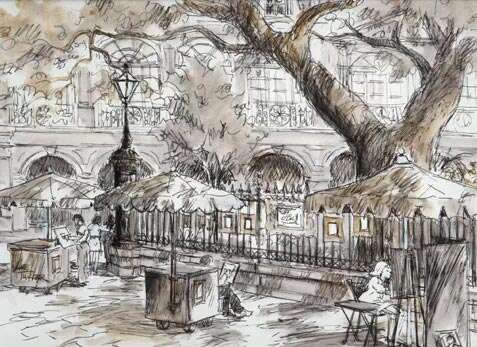Historic Jackson Square Artist Colony

As legend has it, the historic Jackson Square Artist Colony, in the New Orleans French Quarter, dates back to the Civil War when Confederate soldiers wives and widows displayed their art on the fence around the square and sold it to support their families. Doug MacCash, art editor of the New Orleans Times Picayune, writes about this in his article, A Sketchy History of the Art Scene on Jackson Square(6/20/03).
A more certain origin of artists painting, displaying and selling their original work on and around the Square, MacCash continues, dates to 1890 when William Aiken Walker and the Woodward brothers lived in the area.
And there is this morsel: found in an old illustrated calendar is a picture of artists at work around Jackson Square; it is captioned, Before the Civil War, evidence from his writings suggests that John James Audubon painted and sold his work on Jackson Square.
The 1920’s was a busy decade for the artists and left in its wake the beginnings of an organized (albeit subtly) artists’ colony. Most members lived a stone’s throw of the Square, spent their days working there and their nights at restaurants and bars within a moment’s walk from where they lived and worked.
By the 1950’s, with the artists’ colony advertised as a worthy tourist destination in travel magazines such as Gulf Coast Motor Travel, the fame of the Jackson Square artists was spreading across the nation; artists on the Square were proliferating.
Such numbers doing business on the sidewalks of the most historic and frequently visited public space in New Orleans created a rising concern for the city. In 1956, the City Council passed an ordinance which required the artists to be licensed.
This ‘official’ action was the best form of recognition the Artists’ Colony could hope for, even though it necessitated that these bohemian vendors collect and pay city sales tax. In turn, the artists’ right to produce, display and sell original artwork on Jackson Square was legitimized and protected. Their presence and their product was validated by the City of New Orleans.
An immediate effect of the ordinance was its tacit suggestion that the artists self-regulate. The Jackson Square Artists Committee was formed and has operated successfully for over a half century.
In addition, the ordinance stimulated new interaction between the artists, the city and the space; when future territorial battles would occur—and numerous they have been— which pitted the artists against other groups wanting to sell their wares on Jackson Square, the artists would point to their now unequivocal legitimacy, per the city ordinance, as well as to their historical status. Further, the artists would note, they pay for the use of this public space in the form license and sales taxes.
Perhaps the greatest accomplishment of the ordinance was to recognize and give vitality to a true social phenomenon in every sense of the words that define it: a motley crew of beatnik-era, non- conforming bohemian artists effectively organizing and managing themselves for the survival of their community has, in fact, become an unlikely New Orleans institution in its own right.
The Jackson Square Artists’ Colony has grown many world-renowned artists, including Johnny Donnels, Jamie Michalopoulos (aka, Jamie Mitchell), Roland Golden, Pattie Bannister, Dell Weller, Tommy Thompson, Lee Tucker and Bob Graham.
The Jackson Square Artists’ Colony
A self-regulating group of free-spirits who have
created and sold their original art in the open air
of Le Vieux Carre de la Nouvelle Orleans for over a century.
Margaret Whitty © 2003

